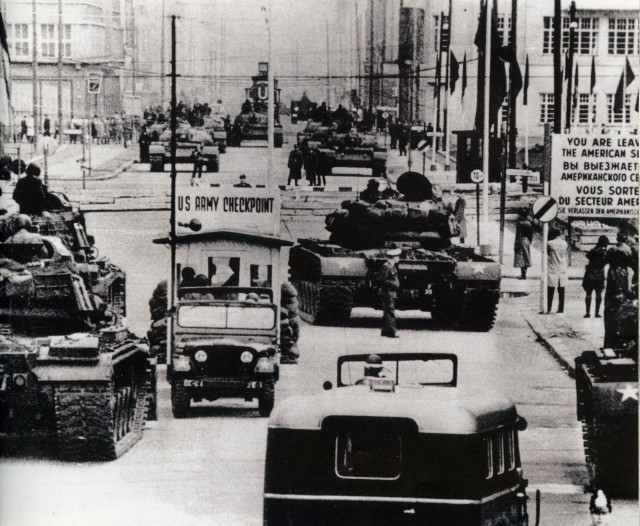On October 27, 1961, combat-ready American and Soviet tanks faced off in Berlin at the U.S. Army\'s Checkpoint Charlie. Tensions between the United States and the Soviet Union over access to the outpost city of Berlin and its Soviet-controlled eastern sector had increased to the point of direct military confrontation.
Postwar Germany was divided by the Allied victors into zones of occupation, and Berlin, located deep in the Soviet zone, was divided into four sectors, each assigned to one of the occupying powers (American, British, French, Soviet). During the occupation, Soviet attempts to interfere with Allied access to Berlin and Allied access to East Berlin (the Soviet sector) caused periodic confrontations and crises. The most notable prior to October 1961 were the Soviet blockade of Berlin in 1948-49 and the construction of the Wall in August 1961. The Wall's construction brought to the crisis stage Soviet efforts to subvert agreements regarding access to Berlin and to the Soviet sector of Berlin. The Soviets sought to compel recognition by the western Allies of the East German state by placing East German border guards in charge of crossing points through the Wall.
The American leadership-General Lucius Clay, in Berlin as the envoy of President John F. Kennedy; the U.S. Commander in Berlin, Major General Albert Watson; and Allan Lightner, Jr., the senior State Department representative-were determined not to recognize the East German border guards as having any authority in Berlin. Repeated Soviet-instigated efforts to restrict access by American personnel to the Soviet sector continued, substantially increasing tensions in Berlin.
To signal American and Allied determination to maintain access rights, the U.S. Army moved ten M-48A1 tanks and three M-59 armored personnel carriers to the Friedrichstrasse Crossing Point, better known as Checkpoint Charlie, usually manned only by U.S. Army military policemen, on October 26. The next day Soviet tanks moved into opposing positions. With the attention of the world fixed on Berlin, American and Soviet tanks, barely one hundred yards apart, faced each other for more than 24 hours with their main guns trained on each other. At the same time, American military and diplomatic personnel with military police escorts continued to move through the checkpoint, exercising their rights to travel into the Soviet sector. On the morning of the 28th Soviet tanks withdrew. Shortly afterwards, the U.S. armor pulled back. The stand-off at Checkpoint Charlie was over.
The Allies had successfully confronted Soviet threats to freedom of movement throughout Berlin, East and West, and proved (with the deployment of Soviet armor) that the Soviet Union, and not the East German government was responsible for the construction of the Wall and continuing efforts to prevent Allied access to East Berlin. For several years, the Berlin garrison (designated the Berlin Brigade in December 1961) was reinforced with U.S. Army combat units convoying on the autobahn corridors from West Germany, serving both to exercise U.S. passage rights and to provide additional combat power in the city.
Decisive and unwavering American resolve, as demonstrated by the U.S. Army under the leadership of General Clay, clearly reaffirmed Allied access to East and West Berlin. Never again would the American and Soviet armies confront one another so directly. And Berlin would remain an outpost of freedom until the reunification of Germany in 1990.
ABOUT THIS STORY: Many of the sources presented in this article are among 400,000 books, 1.7 million photos and 12.5 million manuscripts available for study through the U.S. Army Military History Institute (MHI). The artifacts shown are among nearly 50,000 items of the Army Heritage Museum (AHM) collections. MHI and AHM are part of the U. S. Army Heritage and Education Center, 950 Soldiers Drive, Carlisle, PA, 17013-5021. Website: www.carlisle.army.mil/ahec




Social Sharing